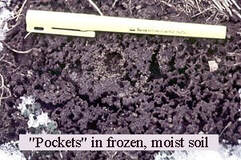 The best time to seed cool-season grasses such as tall fescue and Kentucky bluegrass is September because the turf has more time to mature before spring crabgrass germination and the heat stress of summer. Dormant seeding of turfgrass is sometimes used to help fill in bare spots of lawns that weren't overseeded in the fall. Dormant overseeding is done during the winter (December – February) when it is much too cold for germination. As with any seeding program, good seed-soil contact is vital. Several methods can be used. One method is to seed when there has been a light snowfall of up to an inch. This is shallow enough that bare spots can still be seen. Spread seed by hand on areas that need thickening up. As the snow melts, it brings the seed into good contact with the soil where it will germinate in the spring. Another method is dependent on the surface of the soil being moist followed by freezing weather. As moist soil freezes and thaws, small pockets are formed on the wet, bare soil that is perfect for catching and holding seed. As the soil dries, the pockets collapse and cover the seed. A third method involves core aerating, verticutting or hand raking and broadcasting seed immediately after. Of course, the soil must be dry enough and unfrozen for this to be practical. With any of the above methods, seed germinates in the spring as early as possible. There will be limitations on what herbicides can be used for weed control. Tupersan (siduron) can be used as a crabgrass preventer on new seedings even before they have come up. Also dithiopyr, found in Hi-Yield Turf and Ornamental Weed and Grass Stopper and Bonide Crabgrass & Weed Preventer, can be used on tall fescue, Kentucky bluegrass, and perennial ryegrass two weeks after germination. Dithiopyr is longer lasting and more effective than siduron. Other preemergence herbicides available to homeowners require that the turf be well established before application. (Ward Upham) 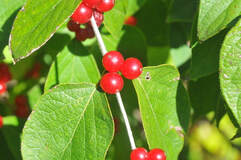 People in the eastern third of the state have been reporting shrubs with bright red berries growing wild. The berries are clustered around the stem and the leaves are still a bright green color. These are likely one of two species of bush honeysuckle, (Amur or Tartarian), which can get 6-20 feet tall. This landscape shrub has become a serious understory invasive throughout the midwest from eastern Kansas to Ohio. Many states have it on their noxious weeds list. All of our native honeysuckles are vines, similar to the vining Japanese honeysuckle. Bush honeysuckles are also noticeable in the spring as they put out leaves much earlier than most other trees and shrubs. Leaves also stay green much later into the fall. This long growing season gives it a competitive advantage over other native species, and the vigorous growth can take over a woodland understory, reducing the number of native woodland wildflowers and other shrubs. If you want to promote native species on your property, then controlling bush honeysuckles is needed. Honeysuckle seedlings can be readily hand pulled when the soil is damp. Chemical control is needed for larger infestations, as cutting alone results in vigorous resprouting. Foliar applications of glyphosate (i.e., Roundup) in late summer and fall works well as does applications of Crossbow (2,4-D + triclopyr). Treating cut stumps with concentrated (20% - 50%) glyphosate is also quite effective. Several studies have shown basal spraying with triclopyr (Garlon) not to be effective, while basal applications with 2,4-D or picloram products work well, using an oil carrier to penetrate the bark. Cut stump and basal treatments can be done when the areas to be sprayed are dry and not frozen. Please follow all label instructions when using pesticides. (Charlie Barden and Ward Upham) 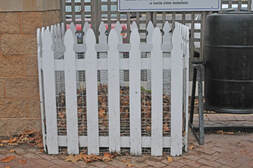 Compost piles should be turned about once per month even during the winter months. This will ensure the composting process continues and that all materials are equally composted. A compost pile is “turned’ when uncomposted material is moved from the sides and tops of the pile to the center where it provides “fuel” for the microorganisms that break it down. Water may need to be added if the material you move to the center is dry. Check the moisture content by squeezing a fistful in your hand. It should feel moist but no excess water should drip out. Compress the material in the pile as best you can as excess air can slow the composting process. (Ward Upham) 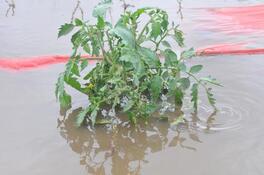 Winter is often a good time to fix areas in the garden where water sits and does not drain properly. Such areas often harm plant roots due to poor oxygen levels in the soil. Consider adding good topsoil so water doesn’t sit. Be sure to till or spade the area to mix the new topsoil and the underlying existing soil. Plant roots do not like to cross distinct barriers caused by one type of soil sitting on top of another. Internal drainage can be improved by adding organic matter such as peat moss, rotted hay, cotton burrs, rotted silage, tree leaves or compost. This can be done by adding a 2- to 4- inch layer of organic matter to the surface of the soil and tilling or spading in as deeply as possible. (Ward Upham) 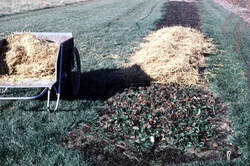 Winter can be a difficult time for strawberries in Kansas. Plants need time to become adjusted to cold weather and will gradually become more cold resistant as fall progresses. Strawberry plants are able to withstand colder temperatures in the middle of the winter than in the fall before they have gone through much cold weather. For example, if temperatures suddenly plummet below 20 degrees F before the plants harden to the cold, they can be severely damaged. A drop to 15 degrees F may kill them. Hardened plants can withstand such temperatures with ease. Normally, strawberries should be mulched for the winter around Thanksgiving. Mulching plants helps protect strawberries not only from low temperatures but also from heaving damage. Heaving damage occurs when the alternate freezing and thawing common in Kansas winters heave plants out of the ground where the roots are exposed and the plants die from lack of water. Wheat straw makes good mulch if it is clean (free from weed seed and wheat kernals). The straw should be spread over the plants to a depth of 3 inches. Shake the slabs of straw apart so there are no large compressed chunks. This straw mulch not only helps protect the plants over winter but can also help avoid damage from late spring frosts by delaying blooming a few days in the spring. Mulch should be removed gradually in the spring as plants begin new growth. Remove enough so leaves can be seen. Leaving some mulch in place keeps the berries off the ground and conserves moisture. Also, mulch left in the aisles helps protect pickers from muddy conditions. (Ward Upham) 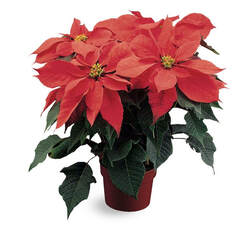 Modern poinsettia varieties stay attractive for a long time if given proper care. Place your poinsettia in a sunny window or the brightest area of the room, but don't let it touch cold window panes. The day temperature should be 65 to 75 degrees F. with 60 to 65 degrees at night. Temperatures above 75 degrees will shorten bloom life, and below 60 degrees may cause root rot. Move plants away from drafty windows at night or draw drapes between them to avoid damage from the cold. Poinsettias are somewhat finicky in regard to soil moisture. Avoid overwatering because poinsettias do not like "wet feet." On the other hand, if the plant is allowed to wilt, it will drop some leaves. So how do you maintain proper moisture? Examine the potting soil daily by sticking your finger about one-half inch deep into the soil. If it is dry to this depth, the plant needs water. When it becomes dry to the touch, water the plant with lukewarm water until some water runs out of the drainage hole, then discard the drainage water. (Ward Upham) 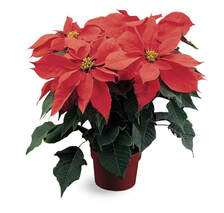 At times, an old time rumor is resurrected that poinsettias are poisonous. This is NOT true. Though there may be an allergic reaction to the milky sap, there has never been a recorded case of poisoning. This rumor has been so persistent that members of the Society of American Florists have sought to dispel it by eating poinsettia leaves for the press. The AMA Handbook of Poisonous and Injurious Plants states that the poinsettia "has been found to produce either no effect (orally or topically) or occasional cases of vomiting. This plant does not contain the irritant diterpenes" which is the toxin in other members of the genus Euphorbia to which poinsettia belongs. (Ward Upham) 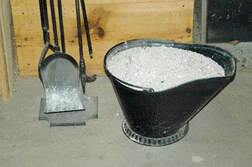 You may have heard that using wood ashes on your garden can help make the soil more fertile. Though ashes do contain significant amounts of potash, they contain little phosphate and no nitrogen. Most Kansas soils are naturally high in potash and do not need more. Also, wood ashes will raise the pH of our soils, often a drawback in Kansas where soils tend toward high pH anyway. Therefore, wood ashes add little benefit, and may harm, many Kansas soils. In most cases it is best to get rid of them. (Ward Upham) |
AuthorsCynthia Domenghini runs the Horticulture Response Center in the Department of Horticulture and Natural Resources at Kansas State University. Other contributors include K-State Extension Specialists. Archives
March 2024
Categories
All
|
| K-State Research and Extension Horticulture Newsletter |
|
 RSS Feed
RSS Feed
